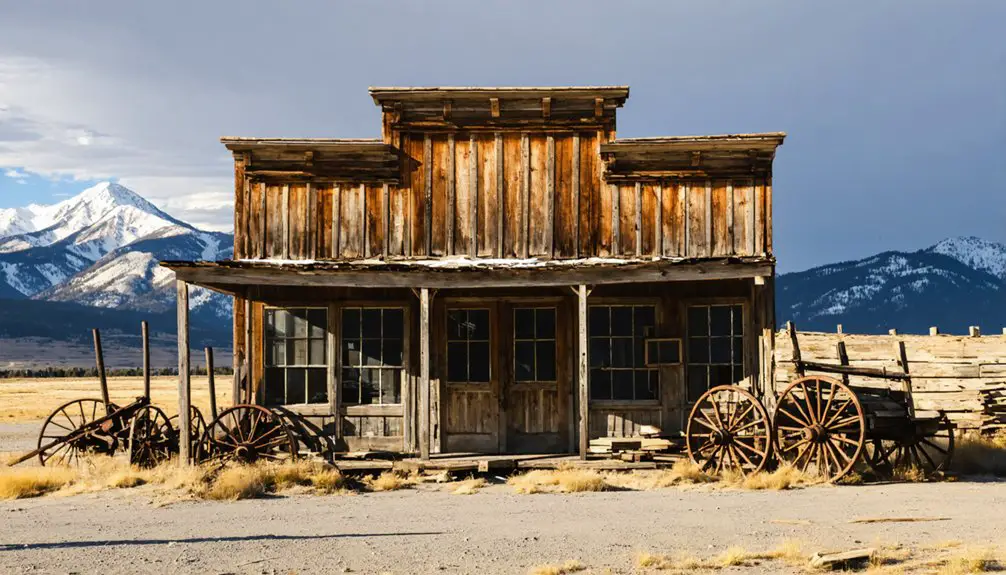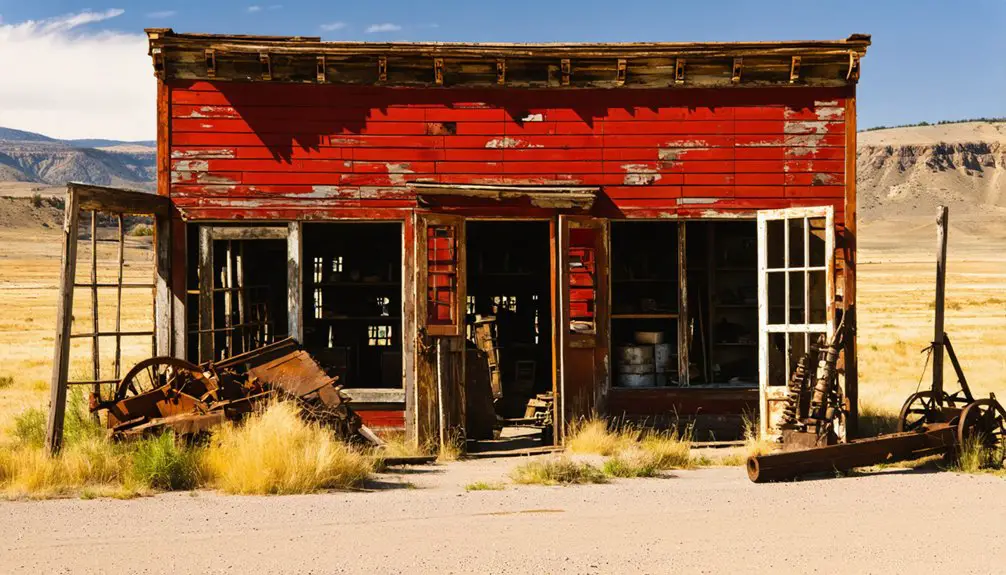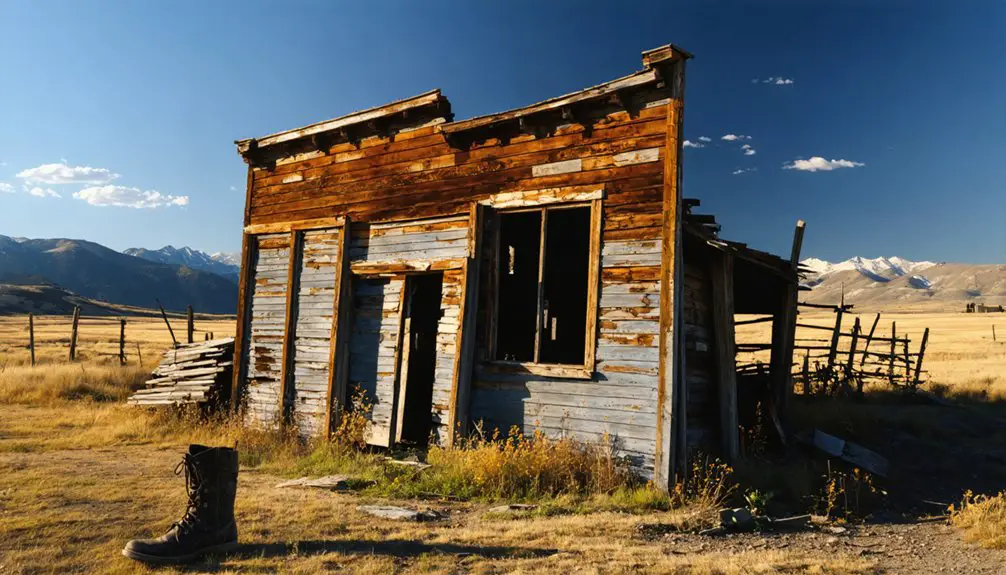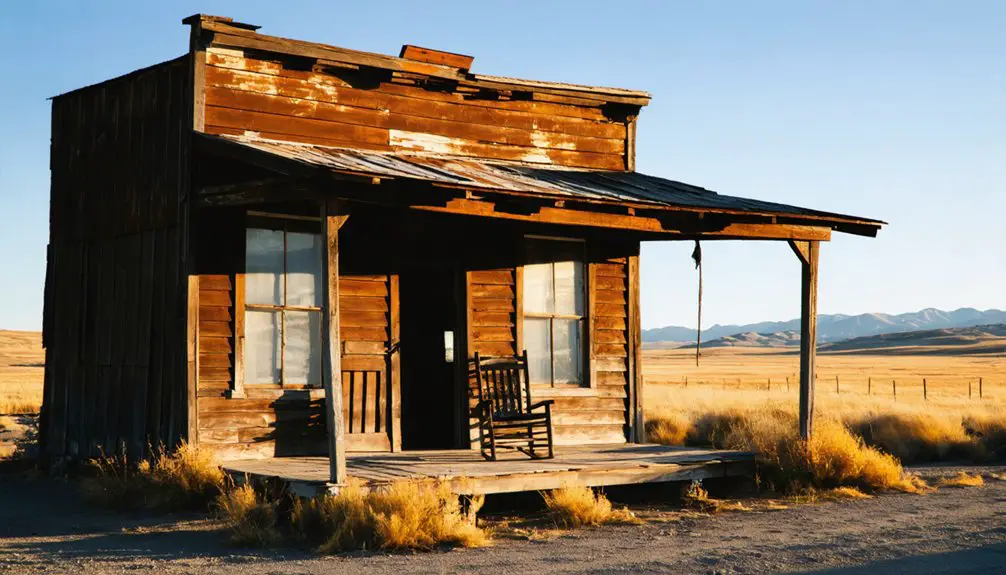You’ll discover Rockvale, Montana’s rich mining heritage in the Hog Heaven district, where the Flathead Mine operated until 1946. The town grew rapidly after 1894 when a post office opened, supporting numerous businesses during the silver boom. After the 1893 silver crash and declining ore deposits, the community struggled, leading to the post office’s closure by 1914. Today, Fort Rockvale Restaurant and Casino stands as a modern landmark, while preservation efforts reveal fascinating layers of Montana’s mining past.
Key Takeaways
- Rockvale emerged during Montana’s mining boom with the discovery of mineral deposits in the Hog Heaven district in the early 1900s.
- The town’s economy peaked in the 1890s with silver mining but declined after the 1893 silver crash and depleting ore deposits.
- The closure of the post office in 1914 marked Rockvale’s transformation into a ghost town as mining operations ceased.
- Few original structures remain, though the preserved cemetery and Fort Rockvale Restaurant and Casino serve as notable landmarks.
- Located at the junction of Highways 212 and 310, Rockvale offers tourism potential through guided tours and historical preservation efforts.
The Birth of a Mining Settlement

When prospectors discovered mineral deposits in Montana’s Hog Heaven district in the early 20th century, the settlement of Rockvale began to take shape.
These pioneering miners initially used basic placer mining techniques, wielding pans and rockers to separate gold from gravel using local water sources. The Flathead Mine silver producer became one of the most productive operations in the region until its closure in 1946.
They built simple shanty towns and cabin rows near the mining operations, creating a community that would ebb and flow with the success of mineral extraction. The settlement’s fate hung on the miners’ ability to strike it rich. Like many early Montana mining communities, the workers endured long workdays for relatively small returns.
When prospectors discovered mineral deposits in Montana’s Hog Heaven district in the early 20th century, the settlement of Rockvale began to take shape. Early settlers, many of European descent, brought their mining techniques from places like Italy, Croatia, and Greece, establishing a diverse workforce in this remote location.
Life During the Boom Years
Life in Rockvale transformed dramatically as the mining operations expanded and workers flooded into the settlement. You’d have found yourself living in simple wooden houses packed tightly around the mines, often without basic amenities like running water or electricity.
As immigrants from Europe poured in, distinct cultural enclaves emerged, creating a patchwork of Irish, Italian, and Slavic neighborhoods. Similar to Red Lodge’s early days, these immigrant coal miners brought their diverse traditions and skills to the region.
Community struggles were constant, from the hazardous working conditions underground to the lack of proper sanitation above. You’d have spent long hours in dangerous mines, facing the daily risks of accidents and lung disease. The 1872 General Mining Act allowed private companies to acquire federal lands, leading to rapid expansion of mining operations and worker settlements.
While saloons and churches provided some social relief, and schools gradually appeared, life remained harsh. Labor unrest occasionally erupted as workers fought for better conditions, though mine owners typically maintained their grip on power.
Economic Rise and Decline

You’ll find Rockvale’s early fortunes tied closely to mining activity that began after its 1894 post office establishment, with the town experiencing rapid growth as a service hub along Route 212.
Similar to Garnet’s boom period, the town supported thirteen bustling saloons. The community reached its economic peak in the late 1890s through steady ore production, supporting numerous businesses including hotels, saloons, and retail shops. Like many mining towns of the era, workers earned about $3 per day.
Rockvale’s prosperity proved short-lived when the 1893 silver crash, combined with declining ore deposits and infrastructure challenges, triggered a downward spiral that led to the post office’s closure by 1914.
Mining Boom Years
As Montana’s mining industry expanded in the 1860s following early gold discoveries, Rockvale emerged within a broader regional transformation that reshaped the territory’s economic landscape.
Similar to other mining areas, operations required regular claim work to maintain active gold mining rights and prevent claim expiration. You’d have found diverse mining techniques evolving from simple placer gold operations to more complex silver and coal extraction methods. The region’s development accelerated when the Rocky Fork Coal Company established operations in the 1880s, bringing new labor challenges and opportunities.
Key developments during the boom years included:
- A surge of multicultural workers, including Finns, Scots, Irish, Italians, and Slavs
- The arrival of the Great Northern Railway, enhancing ore transportation capabilities
- The establishment of multiple saloons and commercial enterprises supporting the mining workforce
These changes transformed Rockvale from a modest settlement into a bustling mining community during the territory’s most prosperous period.
Decline After Silver Panic
When the devastating Silver Panic of 1893 struck Montana, Rockvale’s thriving mining economy crumbled almost overnight. You’d have seen investors fleeing, mines shuttering, and workers losing their jobs as silver prices plummeted. This economic downturn forced many residents to abandon their homes and businesses, seeking opportunities elsewhere.
The town’s mining legacy took another hit as silver veins became depleted below 1,000 feet, prompting companies to shift toward copper and zinc extraction. You would’ve noticed the cancellation of planned railroad expansions and closure of smelting facilities, further isolating Rockvale.
The exodus of miners and their families weakened local institutions, while abandoned mines and processing facilities scarred the landscape. What was once a vibrant mining hub rapidly transformed into a shell of its former self.
Historical Structures and Landmarks
Though Rockvale’s original townsite has largely vanished into Montana’s landscape, a few notable structures and landmarks still tell its story.
Located at the strategic confluence of Rock Creek and the Clarks Fork of the Yellowstone River, the town’s historical significance stems from its position along the Bozeman Trail and role in regional travel. Similar to Virginia City’s remnants, visitors can explore the area to get a glimpse into Montana’s rich historical past. Like many other settlements, Rockvale faced decline when local resources were depleted.
Today, you’ll find these architectural remnants:
- Fort Rockvale Restaurant and Casino (built 1958) – now serving as the area’s primary modern landmark
- A century-old roadside ferris wheel that stands as a distinctive local feature
- The preserved cemetery – one of the few physical links to the original community
The site’s location near Yellowstone National Park made it a vital stopping point for travelers, though most original 19th and early 20th-century structures have now disappeared through decay or dismantling.
Legacy of Montana’s Mining Heritage

While Rockvale’s own mining legacy remained modest, Montana’s broader mining heritage has left an indelible mark on the state’s economic and industrial development.
The discovery of gold near Deer Lodge in 1850 marked the beginning of Montana’s mining industry.
You’ll find that mining has contributed over $150 billion in present-day value since statehood, with Butte alone accounting for two-thirds of this wealth.
Mining innovation flourished in the 1880s as improved transportation and smelting technology transformed the industry’s profitability.
The state’s mining districts showcased remarkable community resilience through boom-and-bust cycles.
You can trace this legacy through Montana’s diverse mineral production, from the silver boom of the 1890s, when output reached 19 million troy ounces annually, to today’s operations that still employ 2,600 people.
The industry continues to adapt, producing essential minerals for electronics, solar energy, and medical technologies.
Preservation Efforts and Modern Status
Today, you’ll find Rockvale’s structures standing as preserved remnants of Montana’s mining era, maintained through collaborative efforts between the Montana Ghost Town Preservation Society and government agencies.
The site draws steady interest from historians and tourists who can explore the remaining buildings during seasonal guided tours and community events.
You can experience firsthand preservation work through educational programs and historical reenactments that help fund ongoing conservation efforts while celebrating the town’s mining heritage.
Current Preservation Status
Despite limited documentation about specific preservation activities in Rockvale, the Montana Ghost Town Preservation Society actively supports the site through broader state-level initiatives and educational programs.
You’ll find various preservation challenges facing the site, including natural deterioration and potential vandalism, though funding opportunities through federal grants and preservation societies help maintain its historical integrity.
Key preservation activities include:
- Structural stabilization projects to prevent further damage to remaining buildings
- Educational field trips and guided tours supported by transportation grants
- Collaboration between land management agencies and local stakeholders for site maintenance
The Bureau of Land Management oversees many ghost town properties, implementing policies that balance public access with conservation needs.
You’re encouraged to participate in community events and volunteer programs that help protect this piece of Montana’s heritage.
Tourism Development Opportunities
Building upon the site’s preservation efforts, Rockvale offers significant tourism development potential due to its strategic location and existing infrastructure.
You’ll find excellent access via Highways 212 and 310, positioning the town as a gateway to wilderness areas and the historic Bozeman Trail. The Fort Rockvale Restaurant and Casino, established in 1958, serves as an anchor for expanding tourism infrastructure.
You can explore opportunities for guided tours, interpretive signage, and cultural events that showcase the town’s mining heritage.
Taking cues from successful ghost towns like Virginia City, Rockvale’s development could include authentic lodging experiences and historical programming.
Through community engagement, local residents can participate as guides and storytellers, while enhanced visitor amenities would support longer stays and deeper connections to this historic site.
Frequently Asked Questions
What Natural Hazards or Wildlife Threats Did Rockvale Miners Face?
You’d face wildlife encounters with bears and mountain lions near mining camps, while natural disasters like earthquakes, cave-ins, and harsh mountain weather threatened your survival underground and above ground.
Were There Any Notable Crimes or Lawlessness Incidents in Rockvale?
Drawing a blank on this one – there aren’t any documented crime statistics or law enforcement records. You’ll find historical focus centers on mining activities rather than lawlessness in surviving records.
How Did Children Receive Education in Rockvale During Mining Operations?
You’d find your kids learning in a one-room schoolhouse with local teachers during mining operations. They’d study basic subjects while balancing their education with family mining duties and seasonal work demands.
What Transportation Methods Connected Rockvale to Other Montana Settlements?
In a horse’s eye view, you’d find wagon trails and the Bozeman Trail connecting early settlers, while aerial tramways moved mining ore. Railroad connections and eventually highways 212/310 expanded your travel options.
Did Any Famous Historical Figures Visit or Live in Rockvale?
You won’t find any documented famous visitors in Rockvale’s historical records. While the town held historical significance along the Bozeman Trail, there’s no evidence of notable figures residing there.
References
- https://getlostinamerica.com/montana-ghost-towns/
- https://www.youtube.com/watch?v=YU0y9_5Ylbg
- https://avrextravel.com/montana-ghost-towns/
- https://www.youtube.com/watch?v=RKTDrpYtzRs
- https://montanahistoriclandscape.com/tag/montana-ghost-towns/
- https://npshistory.com/publications/usfs/region/1/flathead/history/chap3.htm
- https://mhs.mt.gov/education/textbook/chapter6/Chapter6.pdf
- https://visitgreatfallsmontana.org/tenacity-miners-great-falls/
- https://dp.la/exhibitions/industries-settled-montana/mining
- https://www.britannica.com/place/Montana-state/History



